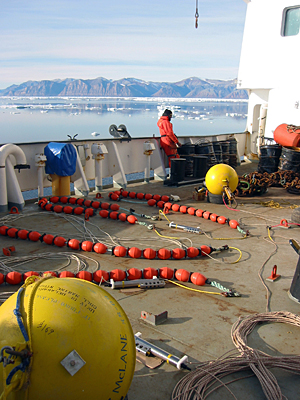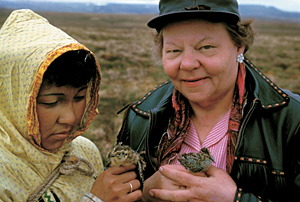

- Rozovsky wins prestigious NSF Early Career Award
- UD students meet alumni, experience 'closing bell' at NYSE
- Newark Police seek assistance in identifying suspects in robbery
- Rivlin says bipartisan budget action, stronger budget rules key to reversing debt
- Stink bugs shouldn't pose problem until late summer
- Gao to honor Placido Domingo in Washington performance
- Adopt-A-Highway project keeps Lewes road clean
- WVUD's Radiothon fundraiser runs April 1-10
- W.D. Snodgrass Symposium to honor Pulitzer winner
- New guide helps cancer patients manage symptoms
- UD in the News, March 25, 2011
- For the Record, March 25, 2011
- Public opinion expert discusses world views of U.S. in Global Agenda series
- Congressional delegation, dean laud Center for Community Research and Service program
- Center for Political Communication sets symposium on politics, entertainment
- Students work to raise funds, awareness of domestic violence
- Equestrian team wins regional championship in Western riding
- Markell, Harker stress importance of agriculture to Delaware's economy
- Carol A. Ammon MBA Case Competition winners announced
- Prof presents blood-clotting studies at Gordon Research Conference
- Sexual Assault Awareness Month events, programs announced
- Stay connected with Sea Grant, CEOE e-newsletter
- A message to UD regarding the tragedy in Japan
- More News >>
- March 31-May 14: REP stages Neil Simon's 'The Good Doctor'
- April 2: Newark plans annual 'wine and dine'
- April 5: Expert perspective on U.S. health care
- April 5: Comedian Ace Guillen to visit Scrounge
- April 6, May 4: School of Nursing sponsors research lecture series
- April 6-May 4: Confucius Institute presents Chinese Film Series on Wednesdays
- April 6: IPCC's Pachauri to discuss sustainable development in DENIN Dialogue Series
- April 7: 'WVUDstock' radiothon concert announced
- April 8: English Language Institute presents 'Arts in Translation'
- April 9: Green and Healthy Living Expo planned at The Bob
- April 9: Center for Political Communication to host Onion editor
- April 10: Alumni Easter Egg-stravaganza planned
- April 11: CDS session to focus on visual assistive technologies
- April 12: T.J. Stiles to speak at UDLA annual dinner
- April 15, 16: Annual UD push lawnmower tune-up scheduled
- April 15, 16: Master Players series presents iMusic 4, China Magpie
- April 15, 16: Delaware Symphony, UD chorus to perform Mahler work
- April 18: Former NFL Coach Bill Cowher featured in UD Speaks
- April 21-24: Sesame Street Live brings Elmo and friends to The Bob
- April 30: Save the date for Ag Day 2011 at UD
- April 30: Symposium to consider 'Frontiers at the Chemistry-Biology Interface'
- April 30-May 1: Relay for Life set at Delaware Field House
- May 4: Delaware Membrane Protein Symposium announced
- May 5: Northwestern University's Leon Keer to deliver Kerr lecture
- May 7: Women's volleyball team to host second annual Spring Fling
- Through May 3: SPPA announces speakers for 10th annual lecture series
- Through May 4: Global Agenda sees U.S. through others' eyes; World Bank president to speak
- Through May 4: 'Research on Race, Ethnicity, Culture' topic of series
- Through May 9: Black American Studies announces lecture series
- Through May 11: 'Challenges in Jewish Culture' lecture series announced
- Through May 11: Area Studies research featured in speaker series
- Through June 5: 'Andy Warhol: Behind the Camera' on view in Old College Gallery
- Through July 15: 'Bodyscapes' on view at Mechanical Hall Gallery
- More What's Happening >>
- UD calendar >>
- Middle States evaluation team on campus April 5
- Phipps named HR Liaison of the Quarter
- Senior wins iPad for participating in assessment study
- April 19: Procurement Services schedules information sessions
- UD Bookstore announces spring break hours
- HealthyU Wellness Program encourages employees to 'Step into Spring'
- April 8-29: Faculty roundtable series considers student engagement
- GRE is changing; learn more at April 15 info session
- April 30: UD Evening with Blue Rocks set for employees
- Morris Library to be open 24/7 during final exams
- More Campus FYI >>
9:58 a.m., March 10, 2009----The University of Delaware's Arctic research and educational resources are featured in a special insert in the current edition of Witness the Arctic, the biannual newsletter published by the Arctic Research Consortium of the United States (ARCUS).
The printed publication is distributed to more than 14,000 arctic scientists, educators, agency personnel, and policy makers. Download a PDF of the document here.
Among the UD research programs and cultural resources highlighted are the following:
- Cosmic ray research, including the Anti-Electron Sub Orbital Payload (AESOP) and Spaceship Earth projects, led by the Bartol Research Institute in the UD Department of Physics and Astronomy.
- The Permafrost Group in the UD Department of Geography, which oversees the Circumpolar Active Layer Monitoring (CALM) program, a global change monitoring network with participants from 15 countries and 160 sites.
- The Sea Ice Experiment: Dynamic Nature of the Arctic (SEDNA), led by researchers in the departments of Geography and Computer and Information Sciences, which is analyzing the interaction among the atmosphere, sea ice, and the ocean to improve predictions of sea-ice cover and impacts on communities.
- Numerous projects led by the College of Marine and Earth Studies, from tracking freshwater fluxes out of the Arctic Ocean, to modeling the interaction between clouds and solar radiation to improve understanding of their effects on climate.
- The nonfiction book Bloody Falls of the Coppermine: Madness, Murder and the Collision of Cultures in the Arctic in 1913, written by McKay Jenkins, Cornelius A. Tilghman Professor of English, and published by Random House in 2005 about the murder of two priests by Eskimos in the Canadian Arctic.
- UD's world-class Inuit art collections, including the Frederick and Lucy S. Herman Native American Art Collection and the Mabel and Harley McKeague Collection of Alaskan Inuit Artifacts, which offer the public insight into the rich culture of the Inuit and serve as an important focus of research and teaching at the University Gallery and the Center for Material Culture Studies.
- A brief history of Arctic research activity at UD, which began with William S. Carlson, who was president of UD from 1946-1950 and a polar researcher.
Formed in 1988 and headquartered in Fairbanks, Alaska, ARCUS is a non-profit consortium comprising member institutions from the United States, Canada, Finland, Germany, Greenland, Norway, Sweden, and the United Kingdom.
The consortium provides leadership in advancing knowledge and understanding of the Arctic through serving as a forum for planning, facilitation, and implementation of disciplinary and interdisciplinary studies, synthesis and distribution of scientific information, and education of scientists and the public.
For more information about University of Delaware polar research and outreach activities, visit this Web site.


